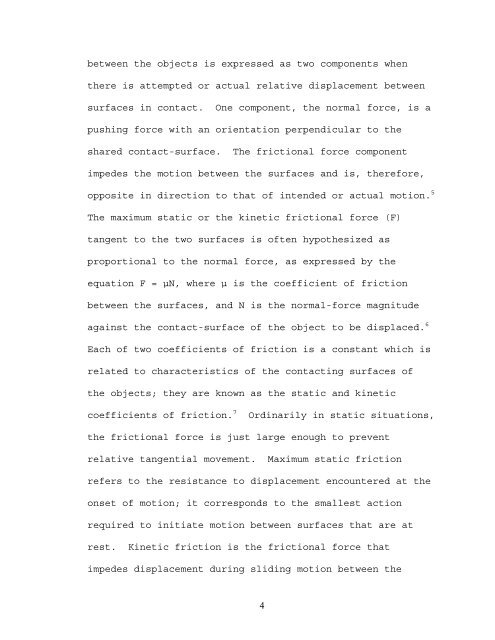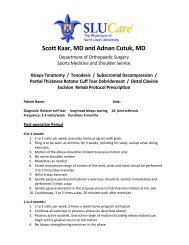The effects of third-order torque and self - Saint Louis University
The effects of third-order torque and self - Saint Louis University
The effects of third-order torque and self - Saint Louis University
You also want an ePaper? Increase the reach of your titles
YUMPU automatically turns print PDFs into web optimized ePapers that Google loves.
etween the objects is expressed as two components when<br />
there is attempted or actual relative displacement between<br />
surfaces in contact. One component, the normal force, is a<br />
pushing force with an orientation perpendicular to the<br />
shared contact-surface. <strong>The</strong> frictional force component<br />
impedes the motion between the surfaces <strong>and</strong> is, therefore,<br />
opposite in direction to that <strong>of</strong> intended or actual motion. 5<br />
<strong>The</strong> maximum static or the kinetic frictional force (F)<br />
tangent to the two surfaces is <strong>of</strong>ten hypothesized as<br />
proportional to the normal force, as expressed by the<br />
equation F = µN, where µ is the coefficient <strong>of</strong> friction<br />
between the surfaces, <strong>and</strong> N is the normal-force magnitude<br />
against the contact-surface <strong>of</strong> the object to be displaced. 6<br />
Each <strong>of</strong> two coefficients <strong>of</strong> friction is a constant which is<br />
related to characteristics <strong>of</strong> the contacting surfaces <strong>of</strong><br />
the objects; they are known as the static <strong>and</strong> kinetic<br />
coefficients <strong>of</strong> friction. 7 Ordinarily in static situations,<br />
the frictional force is just large enough to prevent<br />
relative tangential movement. Maximum static friction<br />
refers to the resistance to displacement encountered at the<br />
onset <strong>of</strong> motion; it corresponds to the smallest action<br />
required to initiate motion between surfaces that are at<br />
rest. Kinetic friction is the frictional force that<br />
impedes displacement during sliding motion between the<br />
4
















